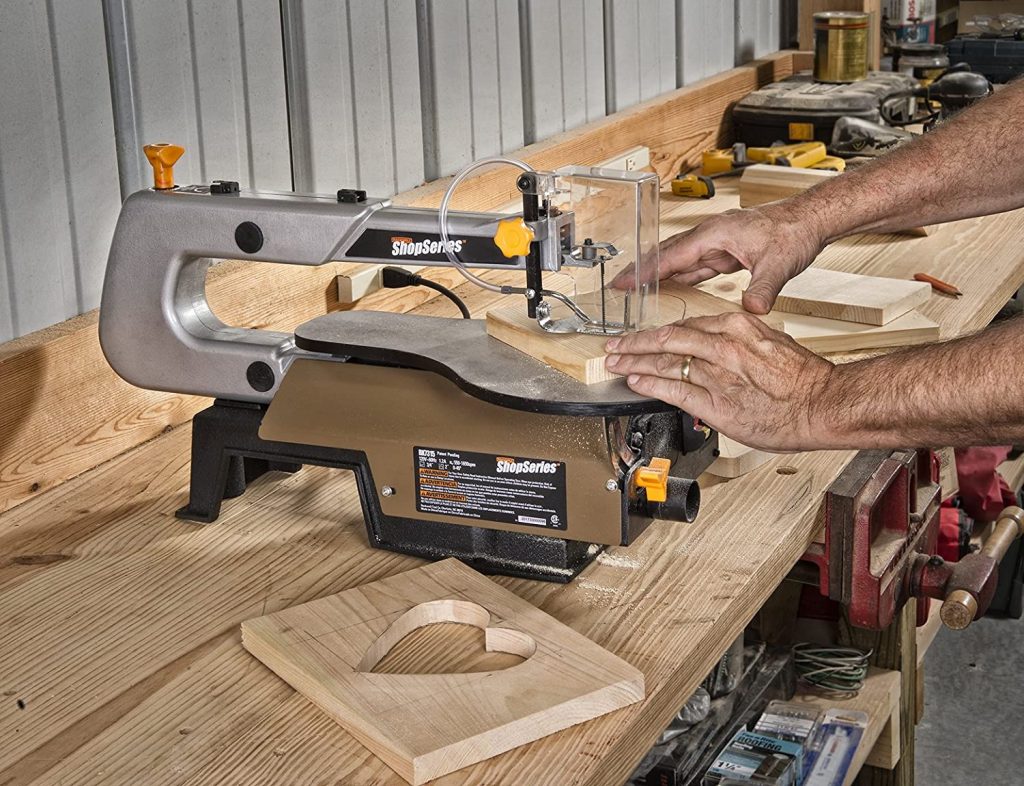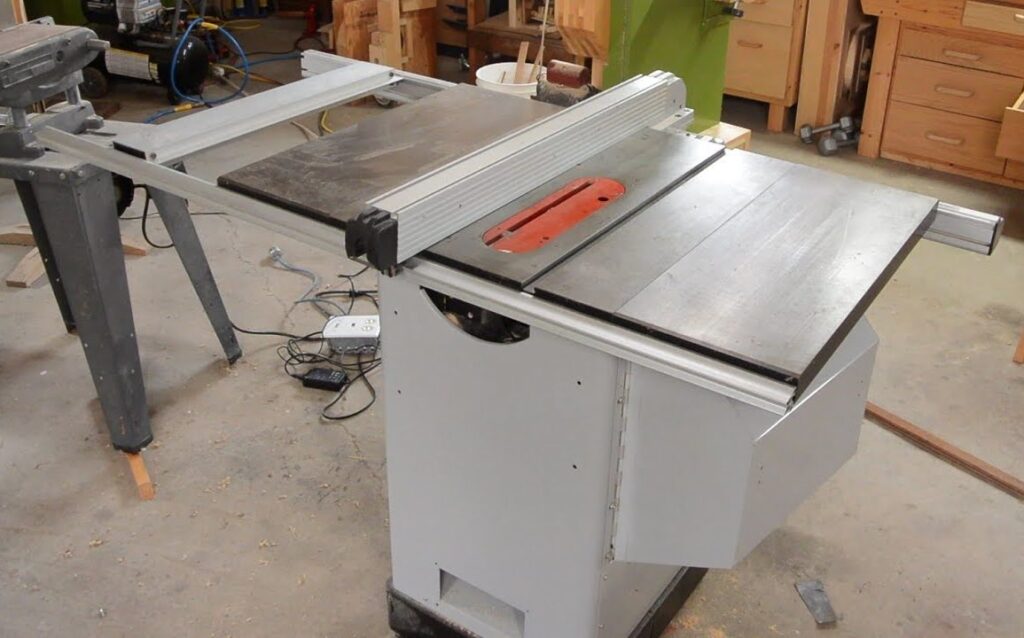There is something common about table saws Trusted Source Table saw - Wikipedia A table saw (also known as a sawbench or bench saw in England) is a woodworking tool, consisting of a circular saw blade, mounted on an arbor, that is driven by an electric motor (either directly, by belt, or by gears). en.wikipedia.org and circular saws Trusted Source Circular saw - Wikipedia A circular saw is a power-saw using a toothed or abrasive disc or blade to cut different materials using a rotary motion spinning around an arbor. en.wikipedia.org – the circular blades that both machines are equipped with. This is why table saws are more often confused for circular saws. Yes, both include similarly designed blades that are propelled by a motor. So, what is the difference between the two types of saw?
In this table saw vs circular saw comparison, we will give you an in-depth description of both woodworking tools. The table saws are tabletop, and circular saws are stationary. The former are usually more expensive than the latter. The table saws are mainly made for professionals with workshops. The sawing results on a table saw are much more precise and smooth. Meanwhile, the circular saws are handheld and are mostly designed for DIYers and professionals on the move and who want a portable saw.
In the rest of the article, we will see the benefits of a table saw vs circular saw as well as the disadvantages of both. We will also see what you can do with a circular saw and a table saw. Keep reading!
A table saw is a circular saw in which a rotating saw blade is firmly integrated into a table. The saw does not have to be guided by hand, so you can concentrate fully on the workpiece to be processed. With the right base, the stationary circular saw, as many manufacturers also call table saws, is ready for use at any time. The saw blade removes chip by chip from the material and in this way achieves a straight and precise cut.
A table saw is a fixed saw, but the angle of the saw blade can usually be adjusted. This makes it possible to saw wood and, with the right saw blade, other materials at different angles. Which angles are available depends on the respective model.
Table saws work very efficiently. They are well suited to making many cuts in a short time. Mistakes are easy to avoid with a little practice. Since the device is integrated into the table, woodworkers can concentrate fully on correctly guiding the material when sawing.
The table and the matching base make handling a saw easy and comfortable, even for beginners who buy an entry-level model.
Different functions and various accessories enable different types of cuts. With the sliding table saw, for example, compared to the simple table saw, there is a sliding table for guiding the workpiece instead of a longitudinal and transverse stop.
There is an electric motor in the table saw, which draws its energy from the mains. A high-voltage connection with a voltage of 480 volts is only necessary for very large professional devices; for almost all other devices, an ordinary socket with a connection of 230 volts is sufficient.
When the motor receives power, it starts to spin. With very efficient electric saws, the saw blade is located directly on the motor – so there is no loss of energy during transmission. Older versions require a V-belt that transfers the movement of the motor to the saw blade.
In addition to the power of the table saw in watts, many manufacturers give the idle speed in revolutions per minute. The higher the speed, the cleaner the cuts with the saw. But be careful: The maximum speed specified for the saw blade should not be exceeded. Failure to do so could result in serious injury. As the size of the saw blade increases, the maximum speed decreases. The cutting speed results from the speed of the table saw. It is given in meters per second. For hardwood, for example, a cutting speed of 50 to 80 meters per second is necessary.
The motor makes the saw blade rotate. The material to be sawed is pushed into the rotating saw blade. With most stationary circular saws, not much can be changed in terms of movement or rotation. Often, however, the saw blade can be inclined to make miter cuts. The corner connection of two elongated workpieces that meet at an angle is called a miter. A miter cut is an angled cut with which it is possible to create such a corner connection. To correctly perform a miter cut, the saw blade of a table saw must have an angle of inclination of 0 to 45 degrees or more.
Table saws are not portable but you can still find a compact one. According to most reviews, the Compact DWE7485 Table Saw for Jobsite, designed by DeWalt is by far one of the most compact and reliable ones. It has 24.5 inches of rip capacity and a 5,800 RPM motor.
A table saw can be used for different jobs. Although the machine is intended for wood processing, you can also saw metal or plastic with the right saw blade and a powerful motor. Professionals and craftsmen also saw parquet or laminate with a table saw. Often, the device helps in the manufacture of beams for interior finishing.
Other areas of application are cutting firewood, sawing thin panels made of aluminum, and adjusting the shape of furniture made of wood. Table saws are also used to cut wooden boards and wooden panels to length. Some table saws can cut tree trunks with a diameter of more than one meter.
A circular saw is often designed compactly. It is handheld and usually has an electric motor. A circular saw will give you straight and long cuts. Also, these devices are perfect for making angled cuts.
The hand-held circular saws can be used to process different materials. You must use a suitable circular saw blade to cut the respective material.
The circular saws are mainly used to cut wood. You can find various saw blades for wood on the market. A saw blade that is specially hardened is useful for processing hardwood. For precise cuts, a fine saw blade with 60 teeth or more would be suitable. And a saw blade with rough teeth would be perfect to roughly cut a piece of wood.
If you want to saw different types of wood, it may be worthwhile to use a universal saw blade for wood.
There are a lot of hand-held circular saws available on the market. The most famous models include the classic circular saws, the mini circular saws, and the plunge-cut saws. Which of these types is best for you depends primarily on the intended use.
If you need a saw with high performance, the classic hand-held circular saw is the idea. If a model with lower output is enough for you, a mini circular saw is an option for you. If you want to make plunge cuts, you have to purchase a plunge saw.
Before using a circular saw, you must clamp a round saw blade into the model. As soon as you switch on the saw, it begins to rotate. Now guide the saw over the workpiece by hand to cut it.
A circular saw allows woodworkers and carpenters to make various cuts. Circular saws make use of round blades that are lined with series of sharp metal teeth. Propelled by the built-in motor which works with a built-in battery or electric power from the mains, the blade works by rotating and cutting wood smoothly. Circular saws also have a handle equipped with a trigger switch, a nut to hold the blade in place and a protection system to prevent any contact between the craftsman and the rotating blade.
The circular saws have become the flagship tools needed in numerous workshops. Ideal for both professionals and DIY enthusiasts, they offer you several advantages: precision, versatility, the multiplicity of supports, or a variety of cuts, are all features that should not be overlooked.
Wood is not the only thing that you can cut with a hand-held circular saw. You can usually also use it for processing the following materials:
Is it worth buying a table saw vs a circular saw? In this comparison table, we will help you answer the question with eight criteria put into consideration.
| Table saw | Circular saw | |
| Ease of use | Table saws require experience | Circular saws are easier to use |
| Ease of maintenance | Relatively easy to maintain | Easier to maintain |
| Materials you can cut | Wood, sheet plastic, sheet aluminum, sheet brass | concrete, metal, brick, asphalt, tile, and stone |
| Price | Between $200 to $500 | Between $30 to $200 |
| Safety | Requires extra care | Safer to use, but require extra care regardless |
| Portability | Often stationary | Usually very portable |
| Accuracy | The most accurate type of saw | Not as precise as table saws |
| Lifespan | 20 years or more | 10 to 20 years |
Do-it-yourselfers like to work with hand-held circular saws because with the help of a hand-held circular saw they can easily cut workpieces from different materials. Depending on the model and saw blade, circular saws can be extremely precise. Hand-held circular saws are mainly used for processing wood. Provided that you equip the circular saws with the appropriate saw blades, they are partly also suitable for cutting through metals and plastics. Some models are even suitable for sawing stones. There are various possible uses for circular saws. For example, you can use such a saw when laying tiles, cutting wooden floors, or building furniture.
Meanwhile, having your table saw opens up new possibilities for DIY. They are also the best saws for professional woodworkers with a workshop. Workpieces can be cut in next to no time. Imprecise and strenuous cuts with a hand saw are a thing of the past. Choosing the right table saw does not always have to be based on the device with the highest wattage often.
Your goals can be achieved with even cheaper devices. In addition to the power consumption, factors such as the speed and the diameter of the circular saw blade play a decisive role.
The table saws and circular saws have a lot in common. They both have very effective blades for different types of cuts. However, a lot of things set them apart.
High-quality table saws have functions such as a soft start, also called soft start or quick stop which ensures safety. The table saw vs circular saw has much more cutting depth. Table saws can have a cutting depth of up to 75 millimeters or more. Table saws are however among the most dangerous tools in the hobby and do-it-yourself sector. That is why some manufacturers install certain protective measures such as the saw blade protection, the motor brake, and overload protection.
Circular saws are easier and safer to use than table saws. They also have safety features built-in. A circular saw impresses above all with its mobility and flexibility. The disadvantage is that these hand-held circular saws are sometimes heavier to handle, especially those with batteries. Also, these models are not ideal for more demanding projects. But they are the best for DIY use.





